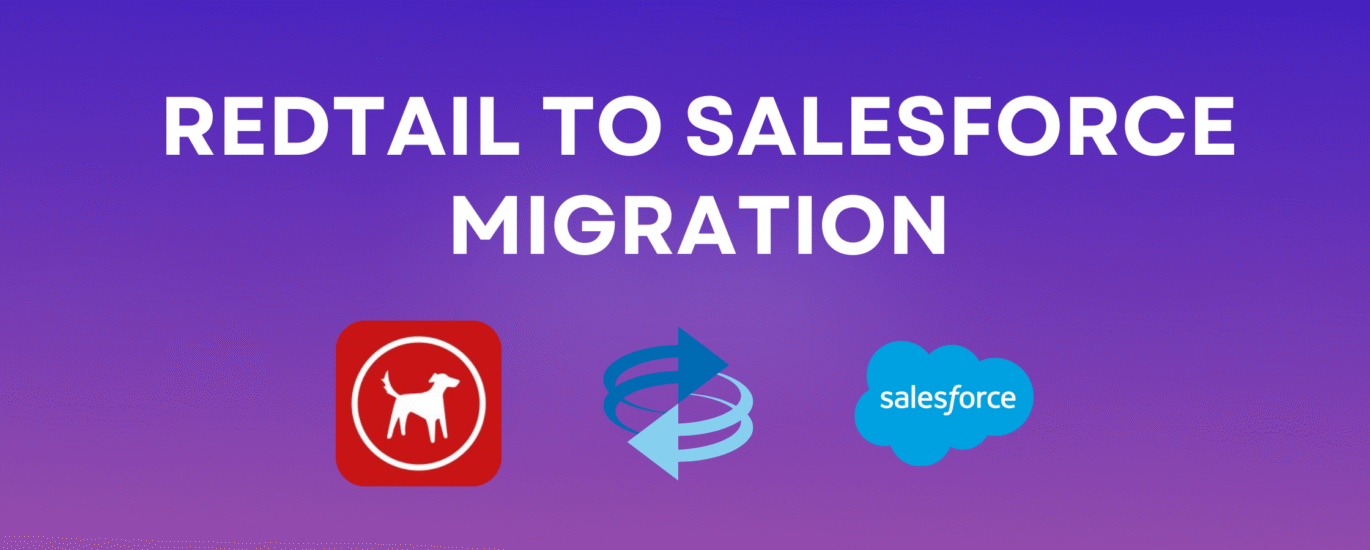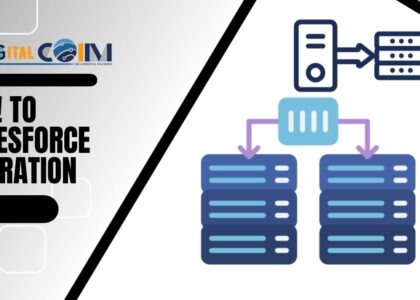For financial advisors, wealth managers, and RIAs (Registered Investment Advisors), a Client Relationship Management (CRM) system is not just a tool—it’s the backbone of daily operations. From managing client interactions to ensuring compliance, the right CRM can make or break efficiency and client experience.
Many advisory firms start their journey with Redtail CRM because it is designed specifically for financial services. However, as businesses expand, firms often feel the need for a more scalable, customizable, and integrated platform. That’s where Salesforce CRM, especially Salesforce Financial Services Cloud (FSC), comes into play.
Migrating from Redtail to Salesforce can seem complex, but with the right strategy, it can transform your client management process. This guide will cover why firms move, challenges faced, migration steps, best practices, and post-migration benefits—making it the ultimate resource for financial advisors planning this transition.
Why Do Firms Move from Redtail to Salesforce?
1. Scalability & Growth
-
Redtail works well for smaller teams, but as your firm grows, it may not scale effectively.
-
Salesforce supports everything from small practices to global enterprises, making it future-proof.
2. Customization & Flexibility
-
Redtail offers fixed workflows, while Salesforce allows firms to build custom dashboards, automate client journeys, and tailor processes.
-
Advisors can personalize CRM workflows for investment planning, estate planning, retirement, and insurance.
3. Integration Capabilities
-
Redtail integrates with financial tools but has limitations.
-
Salesforce integrates with thousands of apps via AppExchange and APIs, including custodians, portfolio management systems, compliance platforms, and marketing tools.
4. Compliance & Security
-
Both platforms are compliant with financial regulations, but Salesforce offers advanced audit trails, encrypted data storage, and role-based access.
-
This makes Salesforce better for large firms dealing with strict compliance requirements.
5. Advanced Automation & AI
-
Salesforce Einstein AI provides predictive analytics, next-best-action suggestions, and automated workflows.
-
Advisors can use AI to forecast client needs, identify cross-selling opportunities, and personalize engagement.
Challenges in Redtail to Salesforce Migration

Moving from Redtail to Salesforce isn’t just about exporting and importing contacts. Firms often encounter these challenges:
-
Data Mapping – Aligning Redtail fields (e.g., “Households,” “Notes”) to Salesforce objects (Accounts, Contacts, Opportunities, Activities).
-
Data Cleansing – Removing duplicates, outdated contacts, and inconsistent formats.
-
Historical Records – Migrating client notes, activity history, and compliance logs without data loss.
-
User Adoption – Teams familiar with Redtail need training to adapt to Salesforce’s advanced features.
-
Workflow Differences – Processes in Redtail may not directly translate into Salesforce workflows.
-
Integration Gaps – Re-establishing integrations with custodians, compliance systems, or financial planning software.
The Step-by-Step Redtail to Salesforce Migration Process
1: Planning & Assessment
-
Evaluate current Redtail CRM usage.
-
Identify essential data to migrate: Clients, Accounts, Households, Notes, Activities, Workflows, Documents.
-
Decide whether to use Salesforce Financial Services Cloud (FSC) or standard Salesforce CRM. FSC is highly recommended for financial firms.
-
Set migration goals: Do you want a simple data move, or full transformation with workflows and integrations?
2: Data Mapping & Cleansing
-
Map Redtail fields to Salesforce objects:
-
Redtail Contacts → Salesforce Contacts
-
Redtail Households → Salesforce Accounts (Households)
-
Redtail Activities → Salesforce Tasks & Events
-
Redtail Notes → Salesforce Notes/Activities
-
-
Clean data before moving:
-
Standardize addresses, phone numbers, and email formats.
-
Merge duplicate clients.
-
Remove outdated leads or inactive accounts.
-
3: Choosing a Migration Method
Firms can choose from:
-
Manual Migration (CSV Export/Import)
-
Export data from Redtail as CSV files.
-
Use Salesforce Data Loader or Data Import Wizard to upload.
-
Suitable for small firms with <10,000 records.
-
-
Automated Migration Tools
-
Tools like Dataloader.io, MuleSoft, Skyvia, or custom ETL pipelines.
-
Ideal for large datasets, ensuring historical records, activities, and notes are preserved.
-
-
Hiring Salesforce Experts
-
Certified consultants handle data mapping, cleansing, and integration.
-
Recommended for firms with compliance-heavy data.
-
4: Test Migration
-
Run a test with a small dataset.
-
Validate that:
-
Contacts are correctly mapped.
-
Historical notes appear under client profiles.
-
Activities and workflows function properly.
-
-
Get advisor feedback before full migration.
5: Full Data Migration
-
Perform migration of all client records, notes, activities, and workflows.
-
Migrate documents and compliance files.
-
Ensure audit trails remain intact for regulatory compliance.
6: Training & User Adoption
-
Provide training sessions on Salesforce dashboards, reports, and workflows.
-
Create custom dashboards for advisors (e.g., client pipeline, AUM tracking, upcoming reviews).
-
Provide cheat sheets and quick-start guides for daily operations.
7: Post-Migration Optimization
-
Monitor data accuracy.
-
Configure Salesforce automations (e.g., client onboarding journeys, meeting reminders, compliance alerts).
-
Reconnect integrations with financial planning and compliance tools.
-
Regularly update Salesforce with new customizations.
Best Practices for a Successful Redtail to Salesforce Migration
-
Plan Ahead – Define scope, timeline, and key users before starting migration.
-
Involve Stakeholders – Include advisors, operations staff, and compliance officers in the planning process.
-
Clean Data First – Migration is the best time to fix bad data.
-
Prioritize Critical Data – Client profiles, historical notes, and compliance logs should never be skipped.
-
Leverage Salesforce FSC – Built for financial advisors, offering household management, client insights, and compliance tracking.
-
Invest in Training – Successful adoption depends on how comfortable your team feels with Salesforce.
-
Work with Experts – A certified Salesforce partner ensures a smooth transition.
Benefits of Migrating to Salesforce
After moving from Redtail to Salesforce companies in usa unlock:
-
360-Degree Client View – All client relationships, activities, financial accounts, and documents in one place.
-
Better Client Engagement – Personalized communications with Salesforce AI.
-
Improved Compliance – Stronger audit trails and monitoring features.
-
Enhanced Productivity – Automated workflows reduce manual tasks.
-
Scalable Growth – Ability to support unlimited clients and advisors.
-
Business Intelligence – Advanced dashboards and analytics for data-driven decision-making.
FAQs on Redtail to Salesforce Migration
Q1. How long does it take to migrate from Redtail to Salesforce?
The migration timeline from Redtail to Salesforce typically ranges between 2 to 6 weeks, depending on the volume and complexity of your data. The process usually begins with a detailed discovery and planning phase, where data structures, custom fields, and workflows are analyzed. Once data mapping is finalized, the migration is executed in stages to ensure minimal disruption to daily operations. Quality assurance testing follows to verify data accuracy, followed by user training and system validation. If integrations or automation workflows are added, the timeframe may extend slightly. Engaging experienced Salesforce consultants can help streamline the process, ensuring a smooth transition with minimal downtime and complete data integrity.
Q2. Will I lose any data during migration?
Data loss is preventable if the migration is executed carefully with precise mapping and validation. A well-structured migration strategy ensures that all your client records, notes, activities, and historical data from Redtail are accurately transferred to Salesforce. The process begins with a comprehensive data audit to identify duplicates, inconsistencies, or obsolete records. Using tools like Salesforce Data Loader or third-party migration software, all relevant data is mapped correctly to corresponding Salesforce fields. After migration, multiple verification rounds are conducted to confirm that all records are intact. Partnering with experienced Salesforce professionals minimizes risks and ensures your complete data set—including communications, appointments, and financial details—is securely preserved.
Q3. Can Salesforce integrate with custodians and financial planning tools?
Yes, Salesforce offers powerful integration capabilities that allow seamless connectivity with popular financial planning and custodial systems. Platforms such as Orion, Black Diamond, eMoney, Morningstar, Envestnet, and Addepar can be integrated to provide real-time portfolio data, client insights, and performance analytics. Salesforce’s open API architecture and AppExchange marketplace make it easy to connect third-party applications without heavy custom coding. For financial advisors, these integrations enable a single unified dashboard that consolidates client financial data, improves efficiency, and enhances client service. Additionally, workflow automation can be set up to sync client updates and transaction histories across platforms, ensuring accuracy and consistency. Integration specialists can tailor connections to meet firm-specific compliance and reporting needs.
Q4. Do I need Salesforce Financial Services Cloud (FSC)?
While Salesforce Financial Services Cloud (FSC) is not mandatory for Redtail migration, it is highly recommended for financial advisors and wealth management firms. FSC is designed specifically for the financial services industry and comes with pre-built data models, relationship mapping, and compliance tools. It streamlines client onboarding, financial goal tracking, and portfolio management—all within Salesforce. Advisors can easily visualize household relationships, monitor opportunities, and deliver personalized client experiences. FSC also integrates seamlessly with financial tools, custodians, and regulatory systems. Using FSC reduces the need for extensive customization and accelerates ROI. Firms using standard Salesforce Sales Cloud can still migrate successfully, but FSC significantly enhances productivity and industry alignment.
Q5. What is the cost of migration?
The total cost of migrating from Redtail to Salesforce varies based on data volume, system complexity, and customization requirements. On average, migration projects range from $5,000 to $50,000+. Smaller firms with limited data and simple setups may complete the process at the lower end, while larger enterprises with complex integrations, custom objects, and workflow automation fall on the higher side. Costs typically cover data extraction, mapping, import, validation, and post-migration support. Hiring experienced Salesforce consultants or implementation partners can add to the expense but ensures accuracy and compliance. Additionally, licensing costs for Salesforce or Financial Services Cloud should be factored in. Investing in expert-led migration reduces long-term operational risks and enhances system performance.
Q6. What are the main challenges during Redtail to Salesforce migration?
Migrating from Redtail to Salesforce can be complex due to differences in data structure, field mapping, and integration requirements. One major challenge is ensuring data accuracy—especially when transferring notes, client activities, and historical communications. Another difficulty lies in customizing Salesforce to match workflows previously built in Redtail. Integrating third-party tools, maintaining data relationships, and setting up automation can also present technical hurdles. To mitigate risks, firms should perform a detailed data audit before migration, use sandbox testing for validation, and engage certified Salesforce experts. Proper planning, documentation, and phased migration ensure a smooth transition, minimizing downtime and protecting sensitive client data throughout the process.
Q7. How secure is the data during migration?
Data security is a top priority during Redtail to Salesforce migration. When handled by experienced professionals, the entire process follows strict compliance standards such as FINRA, SEC, and GDPR regulations. Encrypted file transfers, access-controlled environments, and secure APIs are used to protect sensitive client information. Most migration partners use encrypted connections (SSL/TLS) for data transmission and maintain detailed audit logs. Salesforce itself offers enterprise-grade security, with role-based access control, two-factor authentication, and advanced encryption at rest. Firms are also encouraged to back up their Redtail database before migration for added assurance. With proper safeguards and professional oversight, your client and financial data remain completely confidential and protected.
Q8. Can my team continue using Redtail during the migration process?
Yes, in most cases, your team can continue working in Redtail while the migration is being prepared and tested. The migration process usually begins with a data snapshot or export taken at a specific point in time. This allows consultants to perform data mapping, cleaning, and test imports in Salesforce without disrupting your day-to-day operations. However, it’s recommended to freeze data entry or limit major updates during the final migration phase to prevent discrepancies. Once testing and validation are complete, a final cutover is scheduled—usually over a weekend or low-activity period—to minimize business impact. This approach ensures continuity while achieving a smooth, accurate transition to Salesforce.
Q9. What kind of training is required after migration?
After migrating from Redtail to Salesforce, comprehensive user training is essential for adoption and efficiency. Training typically includes navigation through Salesforce dashboards, client record management, workflow automation, and report generation. If Financial Services Cloud (FSC) is implemented, advisors also learn to use specialized features such as household relationship mapping and financial goal tracking. Training can be delivered through live workshops, webinars, or recorded tutorials customized to your firm’s workflow. Hands-on practice with sandbox environments allows staff to gain confidence before going live. Continuous post-migration support and refresher sessions help maintain user engagement and optimize productivity, ensuring your team fully leverages Salesforce’s powerful CRM capabilities.
Q10. Can I customize Salesforce to replicate my Redtail workflows?
Absolutely. Salesforce is known for its flexibility and can be fully customized to mirror or enhance your existing Redtail workflows. Through custom fields, automation rules, validation processes, and custom objects, your firm can tailor Salesforce to fit its exact business needs. For example, you can recreate Redtail-style activity tracking, client segmentation, and task reminders using Salesforce automation tools like Flow, Process Builder, or Apex triggers. Dashboards can also be configured to display client pipelines, AUM reports, or service metrics. Working with a Salesforce implementation partner ensures that customization aligns with your compliance requirements and long-term scalability goals, allowing you to modernize operations without losing familiar processes.
Conclusion
Migrating from Redtail to Salesforce is not just a CRM upgrade—it’s a business transformation. While Redtail serves as a strong entry-level CRM for advisors, Salesforce provides unmatched customization, compliance, and scalability for growing firms.
With the right planning, data cleansing, and expert guidance, firms can ensure a smooth transition and unlock the full power of Salesforce.
🚀 If your financial practice is ready to scale, now is the time to make the move from Redtail to Salesforce and gain a future-proof CRM that grows with you.





